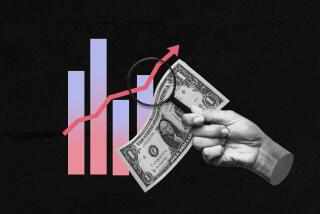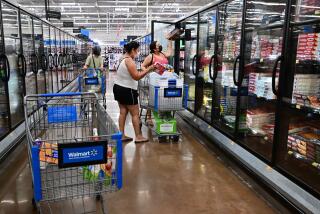Middle, Lower Classes Feel Pinch
WASHINGTON â The annual income of middle-class Americans fell by about $500 each last year, and the number of people in poverty rose by 1.7 million, the Census Bureau reported Friday, showing the lingering effects of the countryâs long economic downturn and suggesting the political trouble that may lie ahead for President Bush.
The census data marked the second straight year of such discouraging trends after nearly a decade of continuous improvement. The rise in those classified as living in poverty suggested that the damage of the 2001 recession was finally beginning to reach low-income groups, which had been surprisingly resistant to its ill effects.
Separately, the government said Friday that the U.S. economy grew at a 3.3% annual rate from April through June, slightly faster than the 3.1% rate it had previously estimated and its fastest pace since last fall. Higher growth usually increases income and reduces poverty, but with employers still slashing payrolls, it is unlikely that has happened yet.
There were 3 million more poor people last year than in 2000, shortly before the economy slipped into recession, according to the Census Bureau. Nationally, a family of four earning less than $18,244 a year is classified as living in poverty.
And, at $42,409 after adjusting for inflation, median income was 3.3% below where it had been two years earlier, census figures showed. Half of all Americans earn more than the median income, while half earn less.
Analysts said the income and poverty trends have very likely deteriorated further this year. The recession officially began in March 2001 and continued through November of that year, but economic growth since then has been on again, off again.
âWeâre in the midst of an economic downdraft and thereâs more bad news to come,â predicted Syracuse University economist Timothy M. Smeeding. âMy guess is that the ... numbers for this year are going to be worse than they were for last year.â
In California, census figures show that last yearâs median income decline appeared more pronounced than for the nation as a whole, dropping $725, or 1.5%. But census officials cautioned that the agency measures state trends slightly differently from national ones, so the two figures are not directly comparable.
Officials also pointed out that at $47,724, the stateâs median income was higher than the nationâs, so its decline did not represent quite as substantial an economic setback.
In terms of poverty, the California rate climbed two-tenths of a percentage point to 12.8%, according to the Census Bureau. The national poverty rate rose four-tenths of a percentage point, to 12.1%. Some 34.6 million Americans were counted as poor in 2002, up from 32.9 million in 2001.
As with incomes, the state and national poverty rates are measured slightly differently.
The latest income and poverty trends might spell political trouble for any president. But they may prove particularly troublesome for Bush, because the sharpest setbacks have come in swing states, especially in the Midwest. Some are states he either narrowly won or lost in the 2000 election and is thought to need in order to win reelection.
âThis is a very serious threat,â said Bill Schneider, a veteran political analyst with the American Enterprise Institute, a generally conservative Washington think tank, and a commentator for CNN News.
âBushâs biggest problem right now is the loss of manufacturing jobs, and these numbers show how concentrated the damage is in the middle of the country.â
The White House offered an upbeat assessment of the presidentâs ability to revive growth and reverse the latest trends.
âThe poverty rate reflects the economic slowdown and the unemployment situation,â said spokeswoman Clare Buchan. âThe president has a vigorous agenda aimed at helping everyone achieve the American dream and participate in an ownership society,â she said.
Democratic presidential contenders, meanwhile, heaped scorn on the presidentâs performance.
âAnother sign of the Bush administrationâs disastrous record of failed economic policies,â said former Vermont Gov. Howard Dean.
âWith a record like this, he shouldnât be running for president, he should be running for the hills,â added newly announced challenger Wesley Clark.
With the presidential election season approaching, census officials offered 15 different ways to measure income and 10 to gauge poverty -- one apparently for almost any political taste. But virtually all the measures pointed in the same direction -- down in the case of income and up in the case of poverty.
The only one of the alternative measures to jump out was that for after-tax median income, which slid 0.8% last year. The decline was considerably less than the drop in pre-tax income and suggested that the steady stream of tax cuts pushed by the administration has helped cushion the income fall for many Americans.
But the latest income and poverty numbers indicated that a cushion of another sort -- an egalitarian sharing of economic pain among the nationâs income classes and racial and ethnic groups, which had been apparent in the 2001 numbers -- is fading fast.
Among other things, the 2001 numbers showed the poverty rate for whites was climbing at a faster pace between 2000 and 2001 than it did for blacks, Latinos or Asian Americans. And the minoritiesâ income appeared to hold up better than in the past.
In most recessions, minority groups are the first and most severe casualties. But the latest census figures, covering 2002, suggest that this unusual burden-sharing is coming to an end.
While the median income of white households slipped between 0.3% and 0.6% last year, that for blacks fell between 2.5% and 3%, for Latinos 2.9% and for Asians and Pacific Islanders between 4% and 4.5%.
The poverty rate among whites rose between three- and four-tenths of a point, but poverty among blacks rose between 1.2 and 1.4 percentage points. (In contrast to the past, the census last year permitted household members to identify themselves as belonging to several racial groups, making it difficult to give precise figures for most groups.)
âA lot of us were puzzled but pleased [in 2001] when it looked like blacks, single-parent households and other disadvantaged groups were resisting the normal poverty-increasing effects of economic downturns,â said Northwestern University economist Greg Duncan.
âIt doesnât look like they are able to resist anymore,â he said.
âIt looks like the 2001 recession was tough on everybody, even white-collar, highly educated workers, but the recovery has been tough on minorities,â said Jared Bernstein of the Economic Policy Institute, a generally liberal Washington think tank.
Even with these recent changes, several economists, both liberal and conservative, said that the current economic weakness is causing less poverty than in similar periods in the past. They said that almost two years out from the November 2001 end of the most recent recession, poverty among children has risen only about a half of a point. By contrast, at similar stages in the three previous downturns, child poverty had risen between 2 and 3.4 percentage points.
âThereâs no way to put a positive spin on the income decline,â said Gary Burtless, an economist with the generally liberal Brookings Institution. But he said the difference in recent poverty figures shows that âthe labor market is not turning against low-skilled people the way it did during most of the last 20 years.â
The latest numbers show âthis has been a very unusual recession,â according to Robert Rector, an economist with the conservative, Washington-based Heritage Foundation. âItâs been a long one, but a very shallow one.â
More to Read
Get the L.A. Times Politics newsletter
Deeply reported insights into legislation, politics and policy from Sacramento, Washington and beyond. In your inbox three times per week.
You may occasionally receive promotional content from the Los Angeles Times.










